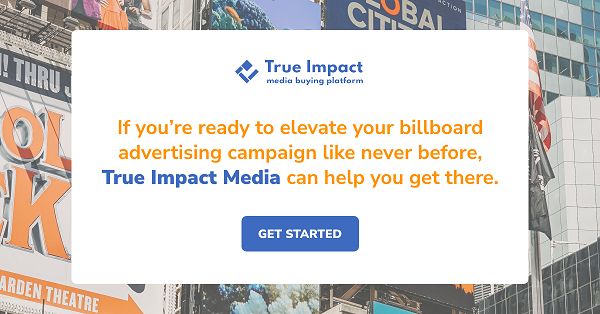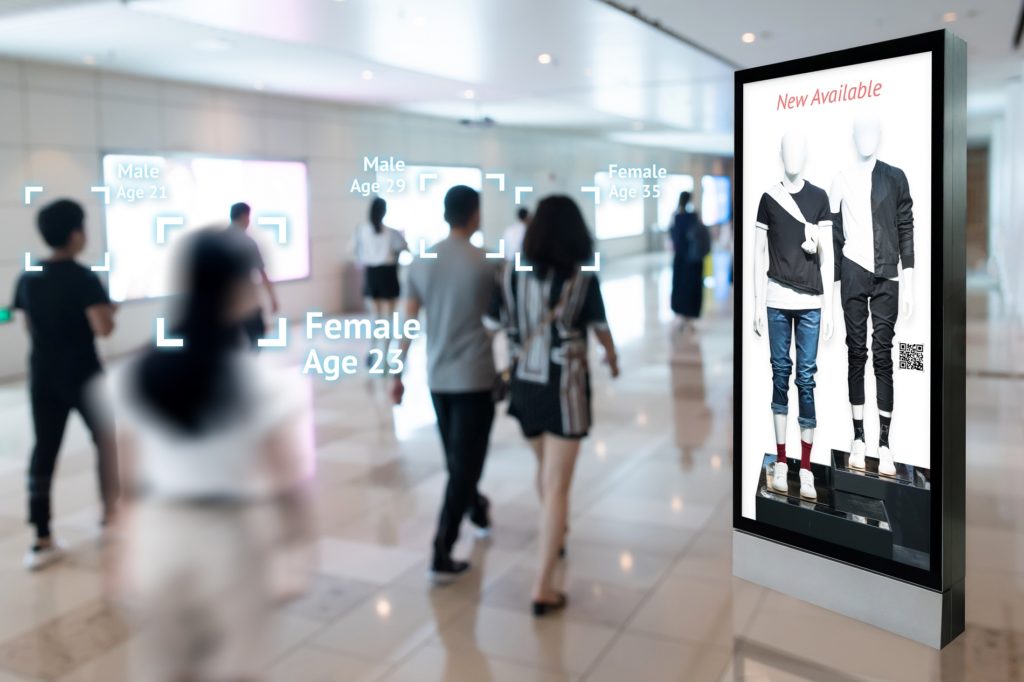The measurement of how a marketing campaign affects a critical indicator is called lift analysis….
Imagine you post an advertisement on both a billboard and a social media page. On the social media post, you can count clicks, views, or scrolls to see the frequency and number of people who see your advertisement. To measure the effectiveness of the billboard, however, you need a different strategy.
Gathering quantifiable data on ad impressions for out-of-home, or OOH, advertising requires a combination of strategies that use multiple sources of information. Read on to learn more about how to calculate impressions from the tiniest bulletin to the largest arena screen. We will be covering the importance of outdoor advertising in your marketing campaigns.
What is OOH Advertising?
Simply put, outdoor advertising options include any ads that are designed to reach consumers outside of their homes. The ad campaign frequently reaches a wider audience than digital advertisements, and they’re a vital part of a diversified marketing campaign. If you’re still wondering, “what is outdoor advertising?,” make sure to read up on the topic to see if OOH advertising is the best marketing strategy for your business’s needs.
Kinds of OOH Advertising
When you think about out-of-home ads, your mind likely goes to billboards. But, outdoor advertising isn’t just limited to signs on the side of the highway. To that end, there are four main types of OOH formats:1
- Transit – Transportation-based OOH is everywhere. Some physical locations have ample room for ad placement, such as airports and bus stations. You can also put ads directly on the modes of transportation themselves, including buses, taxis, trucks, trains, subways, boats, ferries, and even blimps or inflatables. Many of these have the additional capacity for interior advertisements, such as overhead panels on a bus or in-flight entertainment on a plane. Mobile billboards also fall into this category.
- Billboard Rental – If you’ve ever taken a road trip, or even just gotten on the highway, you’ve seen billboards. These large ads are designed to be seen from hundreds of feet away and are built to last. This classic OOH format includes bulletins, digital billboards, wall murals, posters, and spectaculars (billboards with specialized digital or motorized elements). How much does a billboard cost? Our resource center can help you navigate outdoor advertisement spaces to make sure you can find out how much of your budget should be spent on outdoor marketing campaigns.
- Street Furniture – Most urban or suburban areas will have public amenities related to shopping or transportation. Those surfaces are another opportunity to get your message out there. These kinds of ads will be smaller and closer to eye level, displayed so that pedestrians, shoppers, or even people sitting in traffic can easily see them. You will find street furniture advertisements on bike racks, bus shelters and benches, newsstands, pedestrian panels, phone kiosks, and freestanding digital displays.
- Place-based – The ideal location for placed-based OOH is somewhere that has high traffic and can reach large groups of people at once. You might be asking yourself what does reach mean in OOH Advertising? Examples of these kinds of prime locations include arenas or stadiums, movie theaters, convenience stores, shopping malls, coffee shops, restaurants, or gyms. This area of OOH is constantly growing as people come up with creative new locations such as gas pumps or elevators.
What is an OOH Impression?
Impressions are measures that estimate the number of times people view an advertisement. Essentially, they indicate how many times an individual consumer sees your message from your ad campaign.2
OOH takes a different approach to tracking organic impressions and engagement than other kinds of media like radio, television, social media, or print. Instead of counting the exact total number of people exposed to the marketing campaign via viewership data, OOH impressions are a very close average based on activity patterns and engagement.
Both demographic and psychographic data are important to these impression measurements. In other words, you need to know where people are and where they tend to go. Calculating OOH impressions requires real numbers from traffic data, census data, data modeling, and travel surveys.
Usually, impressions are calculated on a weekly basis, so you are always up to date with how often your ad is viewed.
Learning how to calculate impressions can give you a better understanding of:
- Why certain ads are more effective than others
- What locations have the highest performance
- Which types of ads people are most likely to look at
How Do You Calculate Impressions?
There are multiple ways to calculate total impressions—some are more accurate than others. Historically, a common method was using statistics on Daily Effective Circulation (DECs). In more recent years, new techniques developed by the company Geopath have given us a more reliable way to measure total ad impressions.3
Daily Effective Circulation (DECs)

Daily Effective Circulation was the predominant method used for measuring OOH audience sizes and impression share. DECs use traffic data to estimate the number of people, either in cars or other modes of transportation, that could have seen the OOH ad in question.2 They gather the data from the state or area’s department of transportation and put it into the following equation:
- (Number of vehicles) x (Illumination rate of the display in hours) x (Number of average adult passengers in a vehicle)
Unfortunately, DECs only measure the potential number of people who could have seen the OOH, not the number of people who actually observed it. Progress has been made on this problem by an organization called Geopath.
Geopath’s Audience Measurement Ratings
Geopath, formerly known as the Traffic Audit Bureau (TAB), uses audience location measurement, consumer surveys, and market research to provide more accurate measurements of OOH impressions for marketers.
Their goal is to independently audit and report their findings through a rating system, and today many OOH advertisers rely on their data to make important decisions.4
Geopath wanted to better understand potential customer attention, so they used visibility and eye-tracking research to figure out what drivers actually look at on the road. They also incorporate demography, circulation, and trip modeling. The combined approach measures:
- Number of people who pass the ads
- Who the audience is
- What they pay the most attention to
Empirical measurements that Geopath uses in calculating their ratings are:
- Circulation volume
- Consumer demographics
- Geo-positioning (including size, distance to road, and angle to road)
- Maximum noting distance (size of potential contact zone)
- Vehicle speed data
- Dwell time
- Ad noting (via eye-tracking studies and predictions)
- Number of digital ads
- Time of ad display (opportunity to see ads)
In an age of digital billboards and structures that rotate through a number of different on-screen ads, Geopath has also accounted for the differences in audiences for each of the ads that may come on at a given time.
Which Method is Better?
Although Daily Effective Circulation has some merits and can be used as a rudimentary estimate, overall, Geopath’s Audience Measurement Ratings are a more accurate measurement. Because the company’s entire mission is to provide the most accurate measurements, their ratings are likely to be more comprehensive and sound than an initial DEC estimate.
What’s the Difference Between Reach and Impressions?
When measuring an audience, there are a lot of terms that can sound quite similar. For example, reach and impressions. In this article, we have been focusing on viewable impression numbers, which is a measure of the total number of times that people are likely to notice an OOH ad on average.
Reach, on the other hand, focuses on an entire population rather than individuals. Reach is the percentage of your target audience who will notice your ad at least once.2 So, rather than counting repeat exposures, potential customer reach focuses on singular exposures.
To calculate reach, advertisers can use a measurement called the variable adjustment index, or VAI, which measures the percentage of passersby who actually viewed an advertisement. VAIs are also measured using Geopath’s eye-tracking studies and other data such as:
- Road type
- Distance from the road
- Illumination
- Size
- Roadside
- Impact of common board characteristics
Nevertheless, both reach and impressions are important for understanding how well your OOH advertisement is performing.
Why Should I Use OOH?
OOH advertisements like billboards have been a common method of advertising for decades, but that doesn’t mean they’re out of date. Rather, the persistence of physical OOH advertising in an increasingly digital world is proof that there are still many benefits to out-of-home advertising and that it is still just as effective as those first displayed at the 1889 Paris Exposition.
On the internet, the consumer is in complete control over what they see. With people glued to their screens, they can click away, scroll absentmindedly, mute, fast-forward, and block on a whim. Shorter attention spans and fierce competition make it increasingly difficult for advertisers to crack the consumer attention code on digital mediums.
OOH gives the power back to you. By utilizing OOH as a component of your marketing strategy, you can reclaim control over when and where potential customers see your message.
Expand Your Potential With True Impact Media
Whether you are looking for a general guide to OOH advertising costs or wondering what the difference between geo targeting vs geofencing, True Impact Media has all of the resources you need to start your display ad campaign. Calculating total impression numbers and gathering audience estimates are important parts for marketers in any advertising campaign. In OOH advertising, potential impressions are less simple but completely possible to measure.
If you are interested in exploring opportunities to diversify your marketing strategies with OOH advertising, True Impact Media can help. We have expertise in all four categories of OOH media: transit, billboards, street furniture, and place-based OOH. No matter what your vision is for an advertising campaign, we can help it come to life.
Free from upfront fees or contracts, True Impact Media acts as a partner in your creative visions. We help you figure out what options could be right for you and plan effective campaigns, without the exorbitant prices of legacy organizations.
Get started with True Impact Media and start reaching your maximum target audience today!
Sources:
- Out Of Home Advertising Association of America. OOH Media Formats. https://oaaa.org/AboutOOH/OOHBasics/OOHMediaFormats/OOHMediaFormats.aspx
- Out Of Home Advertising Association of America. OOH Glossary of Terms. https://oaaa.org/AboutOOH/OOHBasics/OOHGlossaryofTerms.aspx
- Out Of Home Advertising Association of America. OOH Measurement. https://oaaa.org/AboutOOH/OOHMeasurement.aspx
- Geopath. Our Research. https://geopath.org/geekout/



